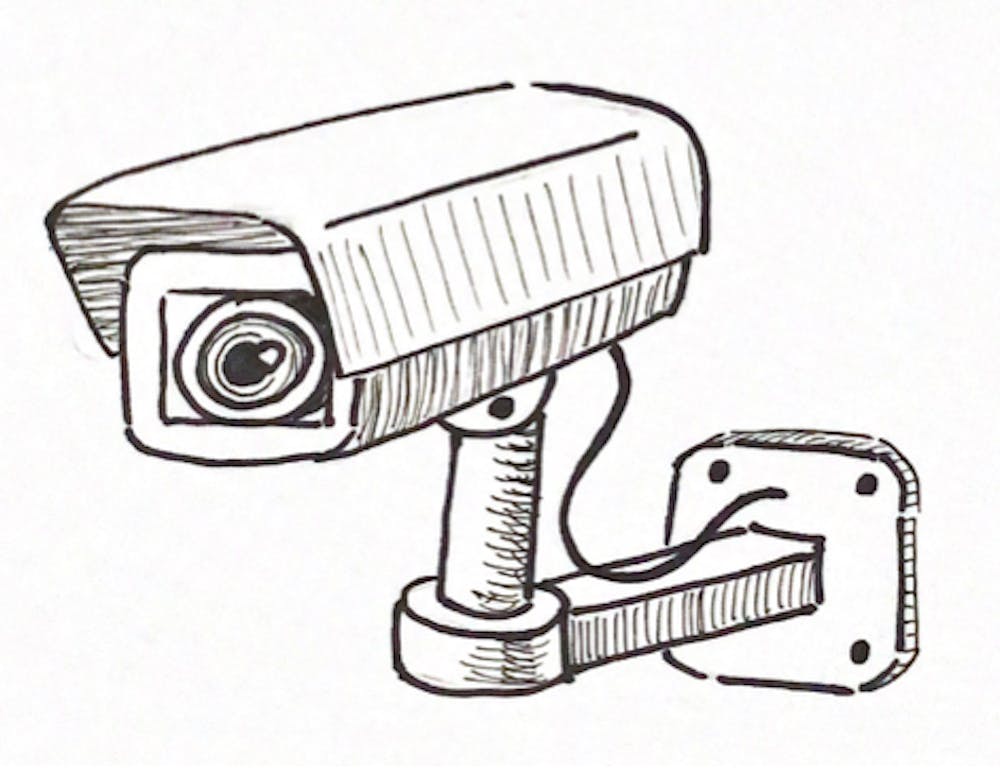Eighteen new security cameras have been installed around campus to update the college’s security system following the approval from the 2019–20 Community Council.
After discussing concerns related to privacy and which groups the use of the camera footage disproportionately affects, the council came to an understanding that they would be placed outside of buildings rather than indoors to prioritize surveillance of external threats and not Middlebury students themselves.
“The hesitancy, and everyone on the council agreed, was that cameras disproportionately affect BIPOC students, so we didn’t want the implementation of these cameras to serve as a way to unjustly punish BIPOC students on campus,” SGA Vice President Roni Lezama ’22 said. Lezama co-chaired the Community Council for the 2019–20 academic year, when the body approved the installation of the cameras.
However, cameras have been installed both inside and outside of McCullough. Interim Director of Public Safety Dan Gaiotti, who is new to his role as Director of Public Safety this year, says he was not aware that the Community Council had come to this understanding.
Security cameras had been a priority for the Department of Public Safety for several years before the installment project officially began last December. The plan was first introduced to the Middlebury community in an email sent in September of 2019. The announcement framed the cameras as a safety improvement for the campus and as a response to concerns raised by the community.
“Cameras are standard practice at our peer schools and 90 percent of colleges and universities around the country. Public Safety's research drew attention to the importance of cameras for safety and security, Community Council endorsed their installation, and cameras are part of our efforts to adhere to best practices in campus safety,” Gaiotti said.
The project was interrupted by the campus closure in mid-March but was completed upon students' arrival this fall. Signage posted in McCullough alerted students of the cameras’ implementation. To date, 18 cameras have been installed — 16 at McCullough and two at Bicentennial Hall.
“Information obtained from security cameras is used for safety and security purposes, and for investigations pertaining to violations of law and Middlebury policies,” Gaiotti said. The specific functions of security cameras include deterrence and detection of violations, property protection and investigative assistance.
In the event of a crime or policy violation occurring near a camera, Public Safety would review the footage to determine if it contains any information that would assist in the investigation. The number of theft reports varies throughout the semester, according to Giaotti. So far, Public Safety has only reviewed camera footage once this semester, after a report that laser projectors were stolen outside McCullough in late October.
The college’s Camera Policy Statement states that audio is not recorded through the camera system and that visual recordings are only stored for up to 30 days.
Security cameras on campus have been a topic of controversy in the past. In 2015, the Community Council voted against a proposal to install new cameras, and concerns about privacy, trust and over-policing led to pushback from students. Spray-painted messages such as “no camera” appeared around campus following the proposal.
These sentiments resonated with current students.
“Having security cameras on campus sets a precedent that Middlebury doesn’t trust their students the same way they do academically with the Honor Code,” Jenny Gold ’23 said. “I think this notion of mistrust affects the relationship between the administration and students. Personal responsibility over belongings is important, and I feel students can assess that themselves.”
Although Gould understood that mistrust may not be the intended message behind the cameras, she believed that is how many students would perceive it.
The camera use, however, goes beyond small incidents of theft within the community. Administrators also pushed for installation as a response to an increase in mass shootings nationwide over the years.
“[The administration’s] interest was not in monitoring what students are up to. They cared more about what was happening on the outside, if there [were] a threat to campus,” Lezama said.
A major point of contention was the issue of which groups the use of camera footage would most likely target. The 2015 down-vote was in large part to prevent over surveillance of BIPOC students on campus. The 2019 council also drew attention to hyper-policing of BIPOC students and how these cameras could perpetuate an oppressive system of surveillance towards certain students.
In addition to cameras, police reform on campus has also been a major topic of discussion this semester following national protests against police brutality and systemic racism. These campus initiatives, however, have not been connected to the new security cameras.
The Department of Public Safety intends to install additional cameras, although the details are not yet finalized.
“There are plans to add more cameras in the future,” Gaiotti said. “The timeframe for installation will depend on several factors, including availability from the vendor.”

Roya Touran '23.5 is a news editor.




